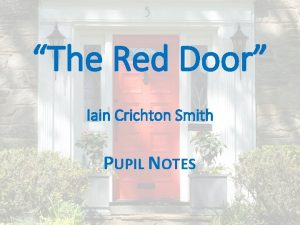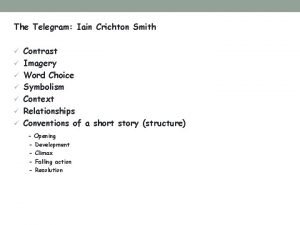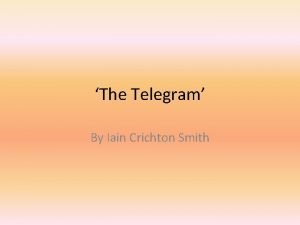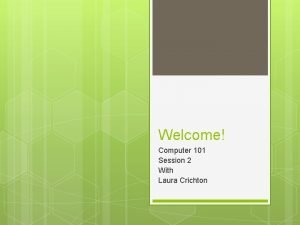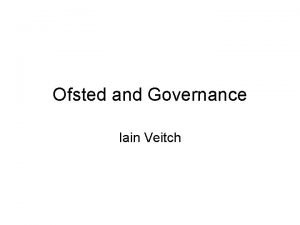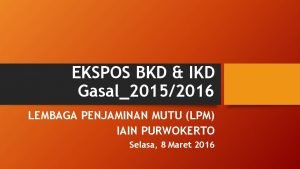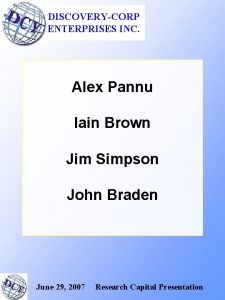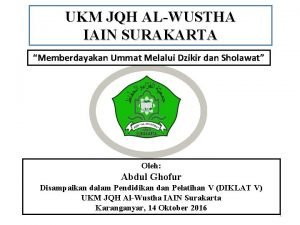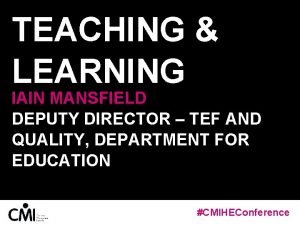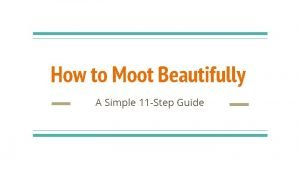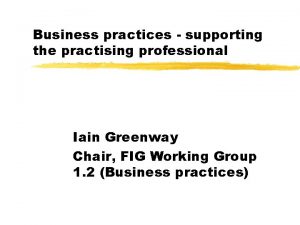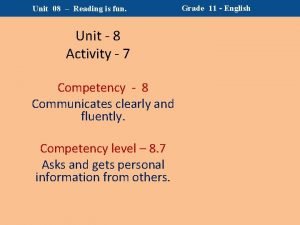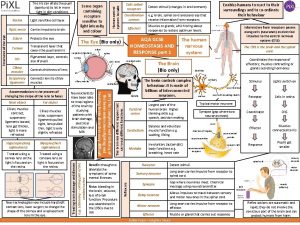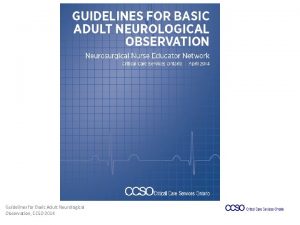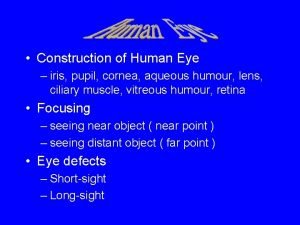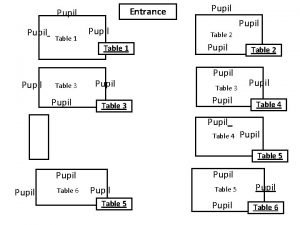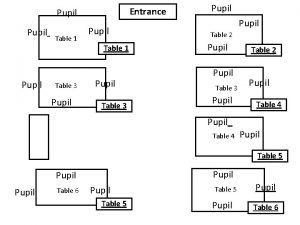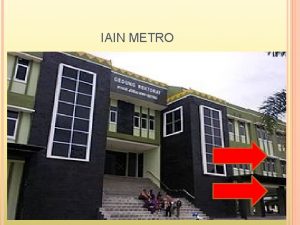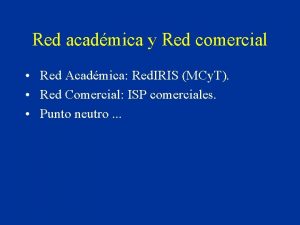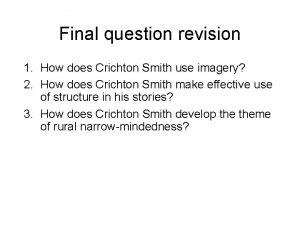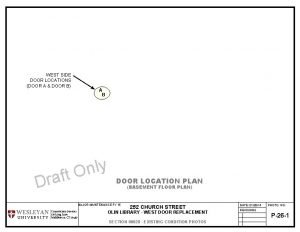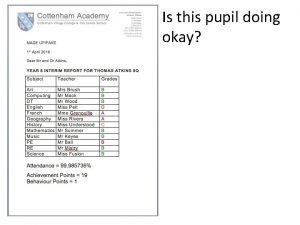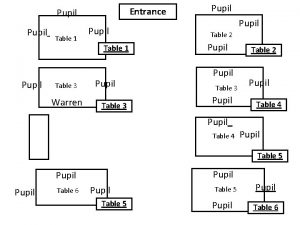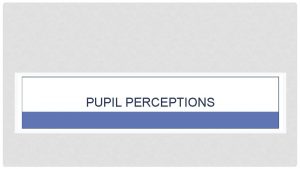The Red Door Iain Crichton Smith PUPIL NOTES






































- Slides: 38

“The Red Door” Iain Crichton Smith PUPIL NOTES

Conformity What does it mean to “conform”? Conformity = a social influence that involves someone changing their behaviour or beliefs to fit in with a larger group (or society in general).

Conformity Advantages and disadvantages of conforming, or “fitting in”. ADVANTAGES • You will be accepted more easily by others • No ‘rules’ will be broken • If you want to blend in, you can (you won’t be noticed) • Society may generally be more peaceful and settled (on the surface) • Everyone knows where they stand with each other DISADVANTAGES • You will lose your individuality – what makes you “you” • You will not be able to express yourself properly • You will be too dependent on others • You will not think for yourself or follow your own dreams/goals • Society would stay still – people who don’t conform can change things for the better

Social Norms A lot of conformity is created through people’s awareness of “social norms”, which are unwritten rules about how we behave in certain situations.

Analysis – Setting 1. Find evidence from paragraphs 1 -6 of the story that tells us: • where/when the story takes place Potential answers • The story is set “after Hallowe’en” and winter is arriving – “Murdo… went out into the cold air” (P. 1); “the winter sun” (P. 4). • Events take place in a small village in the Highlands of Scotland – the name Murdo; “porridge, scones and tea” (P. 1); “He read the Daily Record” (P. 5). • The village is on the coast of Scotland – “the sea was like a strange volume” (P. 6)

Analysis – Setting 1. Find evidence from paragraphs 1 -6 of the story that tells us: • what life in this place is like. • Life here is quite unremarkable, ordinary, bland ‘safe’ – “darned his own socks… cultivated his own small piece of ground” “he slept by the fire… he would converse with his neighbour while hammering a post into the ground… even play draughts with one of them” • The residents of the village seem to live in a deliberately limited, impoverished way – “his frugally prepared breakfast”; “the damp patch on the wall”. • Most importantly, the village seems to be very restrictive and averse to new ideas – “no one in his experience had a red door in the village before”

Analysis – Setting 2. Explain how Murdo’s red door contrasts with the village around it in paragraphs 11 and 12. Potential answers • “it shone with a deep inward shine… it looked like a picture against the rest of the house which… was old and intertwined with all sorts of rusty pipes like snakes” (P. 11) • – Murdo’s house is described very negatively using a simile to make it seem unwelcoming, whereas the door is attractive and remarkable. • “it certainly stood out against the drab landscape as if it were a work of art” – Again, the door seems to be at odds with its surroundings, which are incredibly bland/uniform; it looks like a masterpiece in comparison.

Analysis – Setting 3. How is the setting described in the final paragraph of the story, and what is the change here? Potential answers • “sparkling frost… virginal new diamonds glittered around him” • – This is an extremely positive description of Murdo’s surroundings, highlighting that due to the story’s events the village now seems exciting and fresh to him (sparkling, virginal, new…) and it is a stark contrast to the bland, unremarkable descriptions from earlier in the story. It signals change.

Analysis – Character 4. Look at paragraphs 2 and 5. What are we told about Murdo and his status/standing in the village at the start of the story? Potential answers • He is a bachelor (unmarried), and “had never brought himself to propose marriage to anyone” (P. 2) – this immediately marks him out as quite shy and solitary. The fact that “He lived by himself” (P. 2) is therefore unsurprising.

Analysis – Character Potential answers • He is well liked in the village: “he didn’t offend anyone by gossiping and maintained a long silence unless he had something of importance to say” (P. 2). This suggests that he is wary of how other people view him and wants to conform. He is liked for the wrong reasons and lives to please others. • His desire for acceptance is further revealed in P“he felt it necessary that he should be as like the other villagers as possible. ” • This has led him to have “never in his life done anything unusual” (P. 5), which may indicate that he is repressed (he cannot fulfil his deepest thoughts/desires).

Analysis – Character 5. In paragraph 6, how is it clear that Murdo is a little unsatisfied and does have hidden depths? Potential answers • “there were times when he felt that there was more to life than that” • – This reveals Murdo’s inner need to follow his own path and be an individual, which is being repressed by the village and its unwritten code. • “on summer nights when the harvest moon was in the sky… the earth was painted with an unearthly glow and the seas was like a strange volume which none could read except by means of the imagination” • – The language of his thoughts is quite poetic, almost romantic, which leads us to believe that Murdo is secretly quite a passionate and creative person.

Analysis – Character What impressions are we given of Murdo’s childhood in and how does this explain his behaviour in the village? Potential answers • “he had been a very serious child who found it difficult to talk to children” – He was lacking in confidence. • “had lisped excitedly, ‘Thee, an aeroplane’… which had been repeated as a sign of his foolishness” – He was mocked/bullied by the other children due to delayed speech development. • “He had never taken part in the school sports because he was rather clumsy: and his accomplishments in mathematics were meagre” – He was poor academically and very awkward. This may fuel his desire to conform and be accepted as he never was as a child.

Ian Crichton Smith Analysis – Character 7. How does paragraph 9 make clear why Murdo is a bachelor? Potential answers • He did have a short relationship with a spinster (unmarried woman) in the village, but “ceased to visit her when once she had provided him with cocoa and salt herring… a diet so ferocious that even he could not look forward to its repetition with tranquillity. ” • The woman’s choice of meal is representative of her unpleasantness and joylessness, which Murdo did not enjoy. • This points to a lack of eligible woman in the village, another aspect of the place that means it is unfulfilling for Murdo.

Analysis – Character 8. The TURNING POINT of the story, for Murdo’s character, occurs in paragraph 15. Explain why. Potential answers • He has an epiphany, or realisation, about himself and the village: “I have always sought to hide among other people. I agree to what anybody tells me to do… I have never… been myself. ” • He recognises his own shortcomings and that the village has held back his individuality and expression.

Analysis – Character 9. After Murdo’s realisation, how do his thoughts develop over the course of paragraphs 18, 19 and 25? Potential answers • “But really was he happy? . . . When he considered it carefully he knew that he wasn’t” (P. 18) – He is finally admitting to himself the unfulfilling nature of his life. • “he didn’t like wellingtons and a fisherman’s jersey. He hated them in fact: they had no elegance” (P. 19) – The door has inspired him to express his own feelings and not just be what other people expect him to be. He already has more individuality and freedom of thought than before.

Analysis – Character Potential answers • “It had never occurred to him that he could leave the village, especially at his age” (P. 25) – Another, potentially bigger, epiphany happens here for Murdo: the restrictiveness and influence of conformity within the village is so extreme that he has only just realised that leaving is an option. • “If he were a true villager would he like the door so much? ” – He is questioning his identity, and realising that he doesn’t belong: if the red door inspires him but is not accepted, then the village is not somewhere he wants to consider himself part of.

Analysis – Character 10. How do paragraph 26 and the final sentence of the story show the massive change in Murdo’s character? Potential answers • “He felt a certain childlikeness stirring within him as if he were on Christmas day…” • – This simile makes clear that Murdo feels energised and invigorated by his epiphany. The red door has uplifted and transformed him into an excited childlike state with lots of unexplored potential within him. • “He knocked on the door” • – A satisfying, positive and uplifting final sentence. He is finally free from the shackles of conformity, symbolised by his willingness to knock on Mary’s door.

Analysis – Character of Mary (new colour ) 11. Now consider the character of Mary. In paragraph 10, what are the main reasons she seems to be considered “odd” by the villagers? Is there a clue that suggests she might be responsible for Murdo’s door? • “another spinster in the village who wrote poetry… she neglected herself in the service of books and poetry” – She is creative and therefore does not fit in as the other villagers are repressed and bound by routine and unwritten rules – societal norms (what is accepted and what is not) of village life (orthodoxy of village life) • The fact that she is a spinster (unmarried through choice) and “lived by herself” - suggests that she is isolated, but unlike Murdo has chosen to isolate herself, probably as she realises the village’s attitudes and routines do not reflect her own – she is enlightened and open-minded (contrasting with their close-mindedness). • “was seen pottering vaguely about during the day and sometimes during the night as well” – As she “potters”, a purposeless movement, she is in contrast to the rest of the villagers who seem to always have a set routine and order to their day. Mary being around at night as well emphasises her non -conformist ways and attitude. • “She dressed in red clothes” – The fact that her clothing is the same colour as Murdo’s door, a colour rarely seen in the village, connects her to the door.

Analysis – Character 12. Murdo is inspired to change by the door and, therefore, by Mary. What things from paragraphs 20 and 21 does he find inspiring about her? Potential answers • “Mary had elegance” – Taken in contrast to the previous sentence, where Murdo said his wellingtons and jersey “had no elegance”, we can tell that Murdo sees Mary as representative of everything the village is not. This merely emphasises how her non-conformity is a positive, freeing thing. • “she made no concessions to anybody… her world was her own, depending on none” • – He admires her individuality and her independence, especially in the midst of the village’s restrictiveness.

Analysis – Character Potential answers • “fond of children and used to make up masks for them at Hallowe’en… she was romantic” (P. 21) – She is creative and passionate and Murdo evidently believes she would help him fulfil his hidden desires. That he points out she is “fond of children” also shows he sees her as a potential partner/mother for his own kids. • “she had sudden bursts of rage too which might be the sign of a spirit without servility. One couldn’t marry a clod” (P. 21) – She does not live to please others and will get angry if she feels it was justified. Murdo doesn’t want to marry a “clod” (a stupid person) and here he is obviously viewing her as marriage material for himself. He realises he is attracted to her. • Anger or rage is also often associated with the colour red, another link to Mary/the door.

Analysis – Character 13. Mary does not gossip and is well-read/educated, yet these things lead to her being viewed negatively by the villagers. What does this tell us about their point of view? Potential answers • Not gossiping and being educated would normally be viewed within society as POSITIVE qualities. • The fact that the villagers view these negatively is ironic, and only emphasises their insular (narrow-minded, ignorant or uninterested in others’ points of view) ways.

Analysis – Symbolism = when a feeling, idea, emotion, person, etc. is represented by something else (a physical thing that can be seen). Examples

Analysis – Symbolism What about colours? Discussing with the person sitting next to you, write down all the things you can think of that are represented by the colour RED. Love, passion, anger, danger, blood, fire, heat, embarrassment, hatred, romanticism, murder…

Analysis – Symbolism 14. Draw the following table in your jotter. SYMBOL FROM STORY The red door The children Hallowe’en masks Mary The colour blue The village/villagers The cockerel WHAT IT SYMBOLISES QUOTATIONS ANALYSIS

Analysis – Symbolism Now match the following symbols up with what they represent and find quotations to show each one. (first 2 columns) Symbols • The red door (P. 11, 12, 16, 19, 28) • The children (P. 3) • Hallowe’en masks (P. 3, 25) • Mary (P. 10, 21) • The colour blue (P. 12, 14) • The village/villagers (P. 4, 13, 14, 24) • The cockerel (P. 14) Symbolic of…?

Analysis – Symbolism 14. Draw the following table and complete. SYMBOL FROM STORY The red door(P. 11, 12, 16, 19, 28) WHAT IT SYMBOLISES Individuality/freedom The children(P. 3) Youth/potential/Murdo himself Hallowe’en masks(P. 3, 25) Murdo/pretending to be something you’re not Mary(P. 10, 21) Passion/creativity/nonconformity The colour blue(P. 12, 14) Blandness/restrictiveness The village/villagers(P. 4, 13, 14, 24) Closed-mindedness/ society’s influence The cockerel (P. 14) Freedom and instinct QUOTATIONS ANALYSIS

Analysis – Symbolism Potential answers • The red door = individuality/freedom • “it seemed to express something in himself which had been deeply buried for years” (P. 12) • “The door seemed to have its own courage” (P. 16) • “It seemed to be saying what it was, not what it thought others expected it to say” (P. 19) • “It shone bravely… It said, ‘Please let me live my own life’” (P. 28) • The door represents everything that Murdo wants to be – brave, free, unconcerned by what others are like, unique, non-conformist… It and Mary are linked, since it was she who painted the door and she shares many of its qualities (even wearing red). The door spurs Murdo on to seek his own path and leads him to Mary’s door.

Analysis – Symbolism Potential answers • The children = youth/potential/Murdo himself • “the mask of senility on one face, at the mask of a wildcat on another and at the mask of a spaceman on the face of a little boy whom he could swear he knew” (P. 3) • Murdo is surprised to see the variety of masks the children have chosen to wear, symbolic of the fact that children have potential and can choose to be anything they want to be. The child with the “mask of senility” (old-looking mask) may represent Murdo himself as well as the boy dressed as a spaceman. The fact that he “could swear he knew” him shows he recognises that at one point he had this same potential but has led an unfulfilled life (putting on a “mask of senility” when really he has not experienced anything yet).

Analysis – Symbolism Potential answers • Hallowe’en masks = Murdo/pretending to be something you’re not • “Perhaps his belonging had been like the Hallowe’en mask” (P. 25) • At the end of the story Murdo realises that he has been wearing a mask in the village to protect him from being singled out, just like when children wear costumes and masks at Hallowe’en to fit in with everyone else. This leads him to come to the conclusion that he is not a “true villager” and has been hiding behind his mask, pretending to fit in when he doesn’t, for too long.

Analysis – Symbolism Potential answers • Mary = passion/creativity/non-conformity • “She dressed in red clothes… and was considered slightly odd by the villagers” (P. 10) • “Mary had elegance… the villagers didn’t understand her… she made no concessions to anybody” (P. 20) • “she was romantic… she had sudden bursts of rage” (P. 21) • Mary herself is symbolised by the door and the colour red, which are all linked with creativity, passion and individuality in the story. She also, in a way, represents the unfulfilled desires in Murdo as she shows all of these qualities on the outside whereas Murdo has repressed them. Murdo knocking on her door at the end of the story symbolises his freedom, through her influence, from the shackles of conformity and the pressures of village life.

Analysis – Symbolism Potential answers • The colour blue = blandness/restrictiveness • “as for blue it wouldn’t have suited the door at all. Blue would have been too blatant in a cold way. And anyway the sky was already blue. ” (P. 12) • “Blue smoke was ascending from chimneys” (P. 14) • Blue is linked with village life, as even the smoke rising from chimneys is described as blue – the colour has connotations of coldness, sterility and even sadness/depression. To Murdo, the village seems cold and unwelcoming in contrast to the fiery passion of Mary and the door; “the sky was already blue” highlights this as it suggests that blue is ordinary, or run-of-the-mill. Murdo wants to be ‘red’ as opposed to plain old ‘blue’.

Analysis – Symbolism Potential answers • The village/villagers = closed-mindedness/society’s influence • “no one in his experience had a red door in the village before… It certainly singled him out” (P. 4) • “What would the neighbours say about it… Never in the history of the village had there been a red door before” (P. 13) • “the red door would gather attention to itself” (P. 14) • “the villagers when they woke would see it and perhaps make fun of it, and would advise him to repaint it. They might not even want him in the village” (P. 24) • Murdo’s fear of rejection due to not conforming is represented by his worries about the village’s reaction to his red door. Any time the village is mentioned their stifling, closed-minded influence on him becomes clear. The village is actually used by Crichton Smith to reflect society as a whole, which often has ideas that conflict with that of the individual – it is a ‘microcosm’ (miniature version) of society.

Analysis – Symbolism Potential answers • The cockerel = freedom and instinct • “a cock was crowing, belligerent and heraldic, its red claws sunk into the earth, its metallic breast oriental and strange” (P. 14) • The description of the cockerel carefully likens it to Mary rather than Murdo or the other villagers: it acts on instinct, crowing whenever it feels it should rather than when people expect it to. Its “red claws” are pointed out which links it with the symbolism of the colour red – again Murdo looks at it with envy at this point as he has not yet begun to act on instinct himself.

Analysis – Themes 15. Copy and complete the following information using the words below. One of the main themes in the story is _______ versus _________ wants to be an individual but feels _______ and stifled by the restrictiveness of village life and the attitudes of the ________ around him. Through a ________ woman called ______ he is able to break away from the village’s __________. By ________ his door red during the night she sparks a ________ in him that his life has been _________ as he has spent it all in sacrifice to conformity by leaving all his ______ and ambitions behind to live the way others expect him to. By the end of the story he has become a ________ living for himself alone. unfulfilled Mary controlled individuality restrictiveness passionate villagers desires conformity

Analysis – Themes 15. Copy and complete the following information using the words below. One of the main themes in the story is conformity versus individuality. Murdo wants to be an individual but feels controlled and stifled by the restrictiveness of village life and the attitudes of the villagers around him. Through a passionate woman called Mary he is able to break away from the village’s restrictivness. By painting his door red during the night she sparks a realisation in him that his life has been unfulfilled as he has spent it all in sacrifice to conformity b y leaving his desires and ambitions behind to live the way others expect him to. By the end of the story he has become a non-conformist living for himself alone.

Analysis – Themes 15. Copy and complete the following information using the words below. The other main theme in the story is ____________. Iain Crichton Smith is attempting to convey a message about ______ in general using the behaviour and attitudes of the _________ towards Murdo. In this way, the village is a microcosm of society (a ______ version). This reflects the way most people _______ to what society expects of them without even realising it, unless something (like the ________ or Mary) forces them to confront their true ______ and beliefs. The writer believes that the _______ of fitting in with society often conflict with the desires of the _______ as we are too aware of the closed-mindedness of others to follow our own _____. smaller path closed-mindedness individual pressures villagers conform red door attitudes society

Analysis – Themes 15. Copy and complete the following information using the words below. The other main theme in the story is closed-mindedness. Iain Crichton Smith is attempting to convey a message about society in general using the behaviour and attitudes of the villagers towards Murdo. In this way, the village is a microcosm of society (a smaller version). This reflects the way most people conform to what society expects of them without even realising it, unless something (like the red door or Mary) forces them to confront their true attitudes and beliefs. The writer believes that the pressures of fitting in with society often conflict with the desires of the individual as we are too aware of the closed-mindedness of others to follow our own path.

Analysis – Structure Copy this: • Opening (Key Incident) – Murdo leaves his house on what seems like a normal day to find his door has been painted red. • Turning Point – Having thought about the red door, Mary and his place in the village, Murdo realises that he doesn’t belong and wants to be different. • Climax(Ending) – Murdo knocks on Mary’s door, having decided to begin a new, free chapter of his life.
 The red door short story
The red door short story The telegram quotes and analysis
The telegram quotes and analysis The telegram iain crichton smith text
The telegram iain crichton smith text Iain crichton smith the telegram
Iain crichton smith the telegram The telegram iain crichton smith
The telegram iain crichton smith Door to door luggage service switzerland
Door to door luggage service switzerland Direct energy door to door
Direct energy door to door Define open door policy
Define open door policy Elaine crichton
Elaine crichton Habitus exterior
Habitus exterior Linda crichton
Linda crichton Gc 101 tablet
Gc 101 tablet Elaine crichton
Elaine crichton Sipakatau iain palopo
Sipakatau iain palopo Iain veitch
Iain veitch Lbkd iain purwokerto
Lbkd iain purwokerto Iain giles cibc
Iain giles cibc Iain moffat
Iain moffat Ukm iain surakarta
Ukm iain surakarta Iain mansfield
Iain mansfield Iain shepherd
Iain shepherd 11step guide writing
11step guide writing Iain greenway
Iain greenway Adjunct displays
Adjunct displays Iain park
Iain park Facteur g
Facteur g Yellow belt recorder karate
Yellow belt recorder karate Metaphor poems
Metaphor poems Grade 11 english pupils book activity answers
Grade 11 english pupils book activity answers Non allowable pupil decimal
Non allowable pupil decimal Southeastern states pupil transportation conference
Southeastern states pupil transportation conference Transparent eye layer that protects iris and pupil
Transparent eye layer that protects iris and pupil Pupil path register
Pupil path register Neuro wdl row
Neuro wdl row Brisk eye
Brisk eye Dilatace pupil
Dilatace pupil Construction of pupil
Construction of pupil Festooned pupil
Festooned pupil Eyedoctalk
Eyedoctalk
